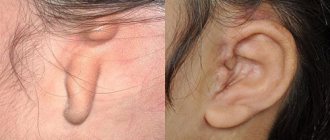History of the operation
Dr. Harry Benjamin
Vaginoplasty is a change of gender from male to female, or vice versa. The first operations of this kind began to be carried out in Europe in the 50s of the 20th century. At that time, skin grafted from the thighs and buttocks was used to create vaginas. The operations had many disadvantages. They left behind numerous scars; the skin might not heal. In addition, sensitive tissue was removed, which led to difficulties in obtaining sexual pleasure and the inability to experience orgasm.
The new technology of vaginoplasty, on the basis of which operations are carried out today, was developed by Georges Bureau in the 60s of the last century. It involves the formation of female genital organs from the skin of the scrotum and penis. This technology has several important advantages: vaginoplasty for men is carried out in one stage, the number of scars is minimal, additional painful skin grafting operations are not required, and the ability for sexual satisfaction is preserved.
This technology was discovered by Buro only in 1973. Dr. Harry Benjamin, who was an American physician who pioneered the study of transsexuality, began systematically referring his patients to Dr. Buro after the discovery of this surgical technology. Today, it has been significantly improved both in terms of maintaining tissue sensitivity and in terms of aesthetics. In 1978, a community of surgeons specializing in plastic surgery of intimate organs was founded in America.
Indications and contraindications for plastic surgery
Plastic surgery of the genital organs is performed for the following indications:
- Transsexualism;
- One year of hormonal therapy prior to surgery;
- Two years of observation by a psychiatrist;
- Obtaining a certificate with the appropriate diagnosis.
Gender change from male to female
Contraindications to gender reassignment:
- Transsexualism was not detected;
- Mental illnesses;
- Homosexuality;
- Alcoholism;
- Minority;
- Elderly age;
- Genetic diseases;
- Drug addiction and other possible individual indications.
Demand for these operations
Each country has its own statistics on plastic surgery of intimate organs:
- America. There is one case of transsexualism in men and 0.25 in women per 100,000 people;
- Singapore. There are 35 cases of transsexualism per 100,000 people;
- England. Over 10 years, 853 operations were performed on men, 12 on women;
- Thailand. Still ranks first in such operations.
World statistics: per 100,000 population there are 1-2 cases of transsexualism.
An interesting fact: if in Western countries plastic surgery of the genital organs is in great demand among men, then in Russia for every 1 case of transsexualism in a man there are 3-4 cases of transsexualism in women.
Cost of gender reassignment surgery
After female to male gender reassignment surgery
The price of gender reassignment varies depending on the country:
- Thailand. This country is the most developed in terms of genital plastic surgery. This is already a separate direction of tourism with all the amenities: a luxury hotel, consultations with the best doctors, surgery and rehabilitation procedures. The estimated price of gender reassignment in Thailand is 7-10 thousand dollars;
- Russia. The cost of psychiatric consultations is approximately 15 thousand rubles, operations – 550 thousand rubles. In Russia, relative to other countries, there is a lack of specialized training and equipment, which is why people usually choose to travel abroad for a gender change;
- America. The price of the main stage of the operation is 40 thousand dollars. The cost of removing a breast is 4 thousand dollars, shaping the penis is 7 thousand dollars, closing the vagina or enlarging the urethra is about 4 thousand dollars;
- Austria. All stages of gender reassignment will cost 13-20 thousand dollars.
Before plastic surgery of intimate organs, hormonal therapy is required for a year.
Consequences of vaginal plastic surgery and benefits
Vaginoplasty helps in solving problems such as excess vaginal volume, scarring in the vagina (after childbirth), and urinary incontinence.
In addition to physiological defects, surgery helps get rid of psychological discomfort and low self-esteem. A number of patients resort to this operation for aesthetic reasons, due to congenital characteristics or age-related changes.
The consequences of vaginal plastic surgery are more positive. Vaginoplasty helps improve sexual relationships, because the increased volume of the vagina interferes with the intensity of sensations due to the loose fit of the vaginal walls to the penis. Vaginal plastic surgery helps to return to a full, rich life and improve relationships in a couple.
Scars that remain after stitching up tears during childbirth also interfere with full sensations. The entrance to the vagina after the healing of the sutures remains wider, as a result of which a woman sometimes loses the ability to enjoy sexual intercourse.
Stages of the operation and its features
Before the operation you must:
- Observation by a psychiatrist for two years;
- Hormone therapy for a year;
- Register with the psychiatric department;
- Pass a special examination;
- Pass a commission to identify transsexualism.
Chastity Bono changed her gender to male
Stages of gender reassignment in men
- Orchiectomy. The testicles are removed, resulting in a reduction in testosterone production in the body;
- Feminizing vaginoplasty. There are several technologies for performing this operation. Most often, female genital organs are created from the tissues of the penis. It is possible to use a vagina made of silicone or other fillers;
- Mammoplasty with implantation of breast prostheses.
Possible additional operations:
Model Lea T is a former man
- Buttock surgery;
- Removal of Adam's apple;
- Waist surgery;
- Facial plastic surgery.
Stages of gender reassignment in women
- Mastectomy. The mammary glands are removed. At the same time, the nipple is preserved;
- Phalloplasty. Creation of a penis from tissues of the labia or body tissues;
- Uterus removal.
Possible additional operations:
- Building muscles, chin;
- Liposuction;
- Facial plastic surgery.
What is laser vaginoplasty
Laser vaginoplasty is a new non-invasive method of treating vaginal laxity syndrome. Like intimate filleting, this manipulation can effectively combat sexual dysfunction in women.
The video below will tell you what laser vaginoplasty is:
Concept
Laser vaginoplasty is a minimally invasive procedure that allows narrowing and tightening of vaginal tissues with minimal risks of complications. It is based on photothermal interaction of mucosal surface tissues with a laser. Warming the tissue leads to an increase in collagen production, which increases strength and elasticity.
In parallel, in addition to tissue contraction, the laser causes a long process of collagen reconstruction, which ultimately leads to rejuvenation. That is why this procedure is also called intimate lifting.
Kinds
There are no types of this procedure. It is carried out using one generally accepted technology, which is the most optimal.
Indications
Indications for the use of this type of plastic surgery are:
- Tissue atrophy;
- Vaginal atony;
- Decreased elasticity and sensitivity of the female genital organ;
- The need to restore the reproductive tract in women after childbirth;
- Prevention of vaginal relaxation syndrome;
- Increased tone;
- Getting rid of stress urinary incontinence syndrome.
Contraindications
Contraindications are:
- Diabetes;
- Oncological diseases;
- Pregnancy;
- Prolapse of the 3rd degree of the pelvic organs with complete or partial prolapse of the uterus;
- Infectious diseases;
- Hemorrhagic diathesis;
- STD;
- Infectious diseases (including tuberculosis of any localization, influenza, seasonal acute respiratory infections);
- Heart failure (with shortness of breath);
- Arterial hypertension;
- Tendency to develop hypertrophic scars;
- Arrhythmia;
- Inflammatory acute pathologies of the pelvic organs;
- Herpes in the acute stage.
Comparison with similar techniques
There are certain types of manipulations in the intimate sphere on the market, which are designed to improve the quality of sexual life and improve health. In comparison with skin grafting, laser plastic surgery has a significant advantage.
- If we take the use of hormonal drugs and special exercises, then the latter have significant limitations in effectiveness. With the help of laser vaginoplasty, it is possible to achieve the best results in a short time. The duration of the effect is approximately 1 year.
- Surgical procedures can bring better results, but also have significant risks. At the same time, there is a risk of reducing the sensitivity of the tissues of the genital organ, which literally has the opposite effect. In addition, a long rehabilitation period is required. But surgical manipulations have a very long period of effectiveness.
- Therefore, laser vaginoplasty is the golden mean between therapeutic, medicinal methods and surgical intervention. An analogous result is intimate filling.
Before and after laser vaginoplasty
After operation
Rehabilitation after sex reassignment surgery includes:
Before and after gender reassignment to female
- Daily vaginal douching;
- Weekly lubrication of the vagina with Levomekol ointment;
- Daily lubrication of seams with Solcoseryl ointment;
- Taking probiotics to restore the microflora of the gastrointestinal tract;
- Daily stretching of the vagina using your fingers.
Additional prohibitions and recommendations during rehabilitation after sex reassignment surgery:
- You can have sex 1.5 months after discharge. Be sure to use special lubricants and condoms;
- You cannot sit for three weeks after leaving the hospital. It is possible to gradually develop physical activity and sit down only from the fifth week after discharge;
- Squatting is not allowed for 6 months after discharge. Physical activity should also be avoided.
Your doctor will give you more detailed recommendations taking into account your individual characteristics.
Rehabilitation period
Full recovery after surgical or laser vaginal plastic surgery lasts about two months; for about another year, a woman needs to observe some restrictions in her lifestyle, for example, not lifting objects that are heavier than five kilograms. In the postoperative period, the first three to five days should be strictly observed bed rest (at this time the woman is still under the supervision of attentive doctors). It is not advisable to sit down for ten days. You can't do any serious housework, exercise, or lift heavy objects for another two months. You are also not allowed to ride a bicycle.
For a year after the intervention, you should not lift anything weighing more than five kilograms. This is a great opportunity to give other people the opportunity to take care of you.
Immediately after vaginal plastic surgery (photo below), you should not eat, you can only drink fruit drinks or clean water. For the first two months, you need to eat only those foods that will not cause increased gas formation or bloating, because this can cause problems in the functioning of the pelvic organs, as well as an increase in intra-abdominal pressure. It is necessary to reduce the amount of solid food in the diet, as it can cause constipation.
Postoperative sutures from the perineum are usually removed on the seventh to tenth day, and from the vagina they are not removed at all, since absorbable threads are usually used for vaginal plastic surgery. Within a week after surgery, you need to treat the area with an antiseptic solution.
Within 2 months after vaginal plastic surgery (the uterus is not affected in most cases, unless necessary), you should avoid intimacy; in the second month, only vaginal contact is prohibited, but you can have anal and oral sex. Even excitement in the first couple of weeks after surgery can have a negative effect: it will provoke blood flow to the organs, which can cause the sutures to come apart, as well as increase post-operative swelling.











